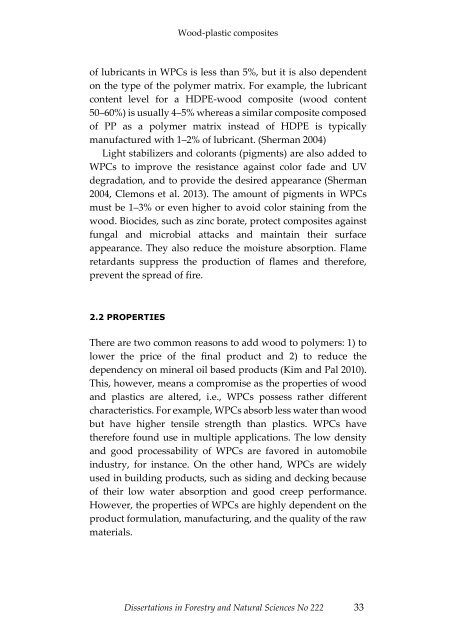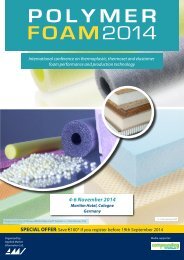Dissertations in Forestry and Natural Sciences
24lYKFN
24lYKFN
You also want an ePaper? Increase the reach of your titles
YUMPU automatically turns print PDFs into web optimized ePapers that Google loves.
Wood-plastic composites<br />
of lubricants <strong>in</strong> WPCs is less than 5%, but it is also dependent<br />
on the type of the polymer matrix. For example, the lubricant<br />
content level for a HDPE-wood composite (wood content<br />
50–60%) is usually 4–5% whereas a similar composite composed<br />
of PP as a polymer matrix <strong>in</strong>stead of HDPE is typically<br />
manufactured with 1–2% of lubricant. (Sherman 2004)<br />
Light stabilizers <strong>and</strong> colorants (pigments) are also added to<br />
WPCs to improve the resistance aga<strong>in</strong>st color fade <strong>and</strong> UV<br />
degradation, <strong>and</strong> to provide the desired appearance (Sherman<br />
2004, Clemons et al. 2013). The amount of pigments <strong>in</strong> WPCs<br />
must be 1–3% or even higher to avoid color sta<strong>in</strong><strong>in</strong>g from the<br />
wood. Biocides, such as z<strong>in</strong>c borate, protect composites aga<strong>in</strong>st<br />
fungal <strong>and</strong> microbial attacks <strong>and</strong> ma<strong>in</strong>ta<strong>in</strong> their surface<br />
appearance. They also reduce the moisture absorption. Flame<br />
retardants suppress the production of flames <strong>and</strong> therefore,<br />
prevent the spread of fire.<br />
2.2 PROPERTIES<br />
There are two common reasons to add wood to polymers: 1) to<br />
lower the price of the f<strong>in</strong>al product <strong>and</strong> 2) to reduce the<br />
dependency on m<strong>in</strong>eral oil based products (Kim <strong>and</strong> Pal 2010).<br />
This, however, means a compromise as the properties of wood<br />
<strong>and</strong> plastics are altered, i.e., WPCs possess rather different<br />
characteristics. For example, WPCs absorb less water than wood<br />
but have higher tensile strength than plastics. WPCs have<br />
therefore found use <strong>in</strong> multiple applications. The low density<br />
<strong>and</strong> good processability of WPCs are favored <strong>in</strong> automobile<br />
<strong>in</strong>dustry, for <strong>in</strong>stance. On the other h<strong>and</strong>, WPCs are widely<br />
used <strong>in</strong> build<strong>in</strong>g products, such as sid<strong>in</strong>g <strong>and</strong> deck<strong>in</strong>g because<br />
of their low water absorption <strong>and</strong> good creep performance.<br />
However, the properties of WPCs are highly dependent on the<br />
product formulation, manufactur<strong>in</strong>g, <strong>and</strong> the quality of the raw<br />
materials.<br />
<strong>Dissertations</strong> <strong>in</strong> <strong>Forestry</strong> <strong>and</strong> <strong>Natural</strong> <strong>Sciences</strong> No 222 33



